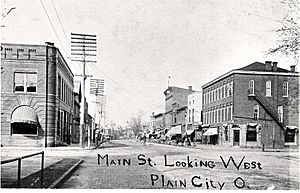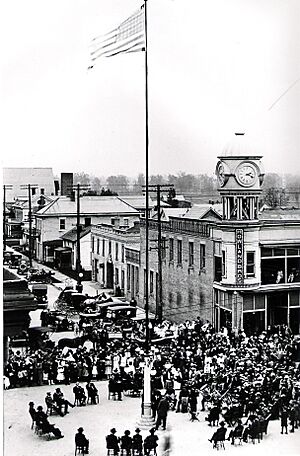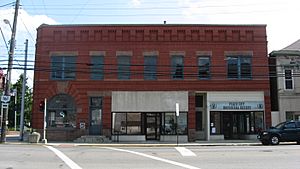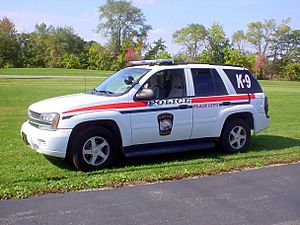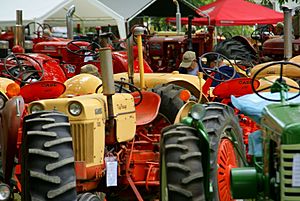Plain City, Ohio facts for kids
Quick facts for kids
Plain City, Ohio
|
|
|---|---|
|
Village
|
|
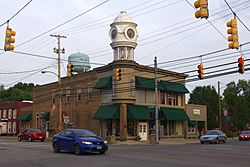
Clock tower, 2013
|
|
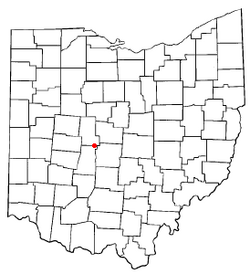
Location of Plain City, Ohio
|
|
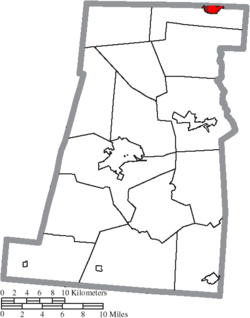
Location of Plain City in Madison County
|
|
| Country | United States |
| State | Ohio |
| Counties | Madison, Union |
| First platted | 1818 by Isaac Bigelow |
| Government | |
| • Type | Mayor-council-boards & commissions government |
| Area | |
| • Total | 2.78 sq mi (7.20 km2) |
| • Land | 1,574.4 acre (7.13 km2) |
| • Water | 12.8 acre (0.07 km2) 1.2% |
| Elevation | 932 ft (284 m) |
| Population
(2020)
|
|
| • Total | 4,065 |
| • Density | 1,477.11/sq mi (570.32/km2) |
| Time zone | UTC-5 (Eastern (EST)) |
| • Summer (DST) | UTC-4 (EDT) |
| ZIP code |
43064
|
| Area code(s) | 614 |
| FIPS code | 39-63030 |
| GNIS feature ID | 2399682 |
Plain City is a small village in the state of Ohio, USA. It is located in both Madison and Union counties. The village is situated along the Big Darby Creek. In 2020, about 4,065 people lived there.
Contents
Plain City's Past: A Look at Its History
Before 1800, the area now known as Ohio was home to Native American tribes. These included the Mingo and Wyandot Indians. There was even a Native American village just north of where Plain City is today.
Around 1795, new settlers began to arrive. They called the area around Plain City "Pleasant Valley." This name was used for a long time, even into the 1900s.
How Plain City Got Its Name
In 1814, a man named Isaac Bigelow came to the area. He bought land from his uncle. Then he went back to Pennsylvania to study medicine.
Isaac Bigelow returned in 1817 and settled in Pleasant Valley in 1818. He hired a surveyor, David Chapman, to help him plan a town. On June 11, 1818, they officially laid out the town of Westminster.
At first, Westminster was only in Madison County. But in 1820, the county line moved. This put the middle of Westminster right on the new county line.
In 1823, the town was re-surveyed. More land was added, and the town's name changed to Pleasant Valley. However, there was already another town in Ohio called Pleasant Valley. So, in 1851, the town changed its name again to Plain City.
Growth and Development Over Time
Before 1850, Plain City was a smaller trading spot than a nearby town called Amity. But things changed when a major railroad line, the Atlantic and Great Western Railroad, came through Plain City. This helped businesses and factories grow a lot.
By 1875, Plain City had many important places. It had five churches, a newspaper, and a bank. There were also different types of stores, like dry goods, drug stores, and grocery stores. The town also had places to make things, like a planing mill and a flour mill.
The Farmers National Bank building was built in 1902. It is located at the intersection of State Route 161 and Chillicothe Street. This building is now a historic landmark. A town clock was also put up at the same intersection on November 15, 1902.
An Amish community was started in Plain City in 1896. This community ended in 2011.
In recent years, Plain City has continued to grow. New neighborhoods like Darby Fields (started in 2017) and Darby Station (started in 2022) have been built. In 2024, Plain City was recognized as a Tree City USA. This means it cares about its trees and green spaces.
Plain City's Location and Area
Plain City is located where two main roads meet: U.S. Route 42 and State Route 161. It's about an eight-minute drive from Dublin. It's also about 12 minutes from Marysville.
The village covers a total area of about 2.40 square miles (6.22 square kilometers). Most of this area is land, with a small part being water.
Who Lives in Plain City? A Look at the Population
| Historical population | |||
|---|---|---|---|
| Census | Pop. | %± | |
| 1880 | 908 | — | |
| 1890 | 1,245 | 37.1% | |
| 1900 | 1,432 | 15.0% | |
| 1910 | 1,407 | −1.7% | |
| 1920 | 1,330 | −5.5% | |
| 1930 | 1,288 | −3.2% | |
| 1940 | 1,385 | 7.5% | |
| 1950 | 1,715 | 23.8% | |
| 1960 | 2,146 | 25.1% | |
| 1970 | 2,254 | 5.0% | |
| 1980 | 2,102 | −6.7% | |
| 1990 | 2,278 | 8.4% | |
| 2000 | 2,832 | 24.3% | |
| 2010 | 4,225 | 49.2% | |
| 2020 | 4,065 | −3.8% | |
| U.S. Decennial Census | |||
The population of Plain City has changed over the years. In 1875, about 700 people lived there. By 1915, the population was around 1,500. The most recent count in 2020 showed 4,065 residents.
Plain City's Population in 2010
In 2010, there were 4,225 people living in Plain City. These people lived in 1,609 households. About 1,150 of these were families.
Most people in Plain City were White (96.0%). A small number were African American, Native American, or Asian. Some people were from two or more races. About 1.5% of the population was Hispanic or Latino.
Many households (37.6%) had children under 18 living with them. Most households (56.3%) were married couples. The average household had 2.63 people. The average family had 3.16 people.
The average age in the village was 37.2 years old. About 29.3% of residents were under 18. About 14.8% were 65 or older. Slightly more than half of the residents were female (52.9%).
Most adults in Plain City have finished high school. Many also have a college degree.
Fun Things to Do: Arts and Culture in Plain City
Plain City has a public park called Pastime Park. It has many things for people to enjoy. You can find baseball and softball fields there. There are also places for camping.
The park has a walking path that is about half a mile long. Kids can play at two different playgrounds. There is also a public swimming pool called Pastime Pool.
Every July, Pastime Park hosts a special event. It's called the Miami Valley Steam Threshers show. This show displays old tractors and other farm equipment. It's a great way to see how farming was done in the past.
Learning in Plain City: Schools and Library
The Jonathan Alder Local School District serves Plain City and the surrounding area. This district includes Jonathan Alder High School.
Plain City also has its own public library. The Plain City Public Library has many books, with over 64,000 volumes. It also offers more than 125 different magazines and newspapers.
Famous People From Plain City
Plain City has been home to several notable individuals:
- Jonathan Alder, an early pioneer and settler.
- Israel Beachy, a bass guitarist.
- James Dillion, who won a bronze medal at the 1952 Summer Olympics.
- Perry A. Frey , a biochemist born in 1935.
- Arnett Howard, a jazz musician.
- Herbert Huffman, a musician and choir director who founded the American Boychoir School.
- Donnie Nickey, a player in the NFL.
- Nanette B. Paul, a legal scholar, lawyer, and author.
See also
 In Spanish: Plain City (Ohio) para niños
In Spanish: Plain City (Ohio) para niños


